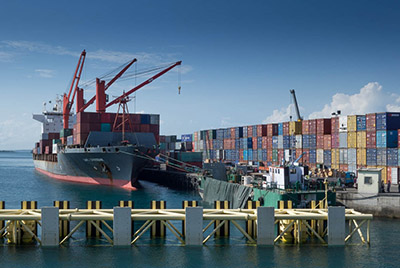Ports address climate change
With the opening of Long Beach Container Terminal, 11 percent of the port’s fleet of cargo-handling equipment is zero-emissions.

When the American Association of Port Authorities (AAPA) convenes its 106th Annual Convention and Expo in Long Beach next month, much of the focus will be placed on climate change and the devastation to ocean cargo gateways in the southeast and gulf hit hard by two recent hurricanes. That’s because environmental stewardship is something that all ports take seriously now…even if they are not in the path of murderous winds and surging seas.
Hosting this year’s event is the Port of Long Beach – which along with several other Pacific Rim seaports – has taken a lead role in championing best “green” practices.
“We’re modernizing our facilities and preparing for an economically strong and environmentally sustainable future,” declares the port’s executive director, Mario Cordero.
The Port of Long Beach notched clean air records in its latest study of air pollution emissions, including an 88 percent reduction in diesel particulate matter, continuing more than a decade of air quality improvements.
The first phase of the zero-emissions Long Beach Container Terminal opened on Pier E in 2016, helping to drive down the air pollution tallied in the port’s annual Emissions Inventory. The port has been monitoring its progress in air quality improvements since 2005.
The inventory, conducted by an independent consultant, found the port’s aggressive actions to cut pollution have decreased diesel particulate matter a record 88 percent since 2005. Smog-forming nitrogen oxides were down 56 percent, also a record. Sulfur oxides held steady at 97 percent lower and greenhouse gases are down 22 percent, another record.
As part of the first Clean Air Action Plan adopted in 2006, the port’s efforts to improve air quality have included the Clean Trucks Program, low-sulfur fuel regulations for ships, increased use of shore power for container ships and the port’s Green Flag Vessel Speed Reduction Program. The port remains focused on continued reductions through increased use of on-dock rail, advanced clean-air technologies, and joint efforts with Port of Los Angeles to finalize the latest update to the Clean Air Action Plan this fall.
With the opening of Long Beach Container Terminal, 11 percent of the port’s fleet of cargo-handling equipment is zero-emissions.
“We have a greater percentage of our cargo-handling equipment operating at zero emissions than any other seaport in the country,” says Cordero. “As we chase our goal of becoming a zero-emissions port, it’s important for us to increase that number to help make the technology more commercially viable.”
The Port of Los Angeles, meanwhile, achieved record clean air gains while moving more cargo than ever, according to the port’s recently-released 2016 Inventory of Air Emissions study. The annual report also shows the port surpassed its 2020 goal for reducing the health risk of emissions from port-related activity.
“The 2016 report validates the benefit of our clean air strategies in combination with improved operational efficiency,” says Port of Los Angeles Executive Director Gene Seroka. “We’re proud of the extraordinary progress we’ve made reducing emissions since 2006, and we’re determined to do more in the years ahead.”
California’s third largest port – Oakland – has also made strides in addressing climate change.
Port of Oakland Executive Director Chris Lytle met with international shipping lines last month to clear the air – literally. He said his port would intensify efforts to curb diesel emissions by plugging more vessels into shore power.
“If there are ways to strengthen our port electrical infrastructure to promote more use of electrical power from our grid, we will do it,” said the port’s boss. “We will collaborate with shipping lines and the marine terminal operators here in Oakland to build on the progress we’ve already made.”
And not a moment too soon, researchers at Stanford University contend. Catastrophic storms are not the only threat facing global ports: the gradual rise in sea levels in the Pacific Basin may be just as damaging.
In a survey posed to port authorities around the world, the Stanford team found that most officials are unsure how to best protect their facilities from higher waterlines. Indeed, results published in the journal Climate Change, indicate that port authorities and other government agencies must make more informed decisions about adapting to warming waters as they plan for the next generation of infrastructure.

Article Topics
Blogs News & Resources
Latest in Materials Handling
Beckhoff USA opens new office in Austin, Texas Manhattan Associates selects TeamViewer as partner for warehouse vision picking ASME Foundation wins grant for technical workforce development The (Not So) Secret Weapons: How Key Cabinets and Asset Management Lockers Are Changing Supply Chain Operations MODEX C-Suite Interview with Harold Vanasse: The perfect blend of automation and sustainability Consultant and industry leader John M. Hill passes on at age 86 Registration open for Pack Expo International 2024 More Materials HandlingAbout the Author
Subscribe to Materials Handling Magazine

Find out what the world's most innovative companies are doing to improve productivity in their plants and distribution centers.
Start your FREE subscription today.
April 2024 Modern Materials Handling

Latest Resources










